|
NPS.gov / Park Home / Learn About the Park / Nature / Animals / Birds / Perching Birds
New World Sparrows are in the Passerellidae family which is a large family of birds that like to eat seeds. They have beaks similar to finches which makes them really good at cracking open seeds and crunching on them. The birds in this family are native to North and South America.
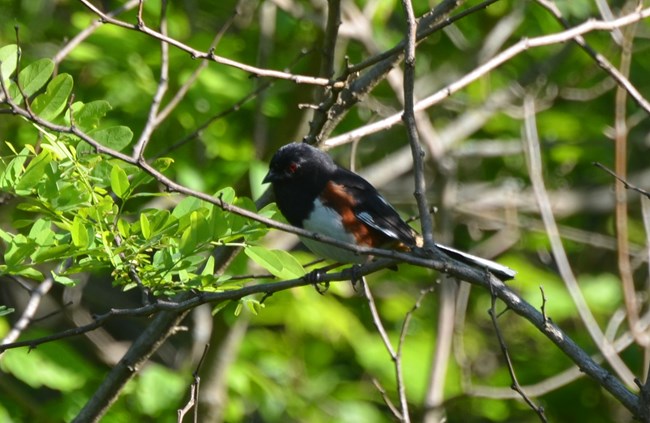
© Bill Telfair Eastern Towhee (Pipilo erythrophthalmus)• Eastern Towhees look for food by rummaging through the leaf litter or by creeping through thick shrubs.• When a female first enters a male Eastern Towhees territory they chase her like she is an unwelcome guest but over the next few days the male becomes more tolerant of the female and then more attentive and eventually follows her everywhere she goes. • They love to eat many different types of food like seeds, fruits, insects, spiders, millipedes, centipedes, and snails Identification Information• Size: Robin sized (Medium)• Color: Males are black on their backs and feathers with reddish/brown and white bellies. Females have the same patterning but are deep brown on their backs and feathers. 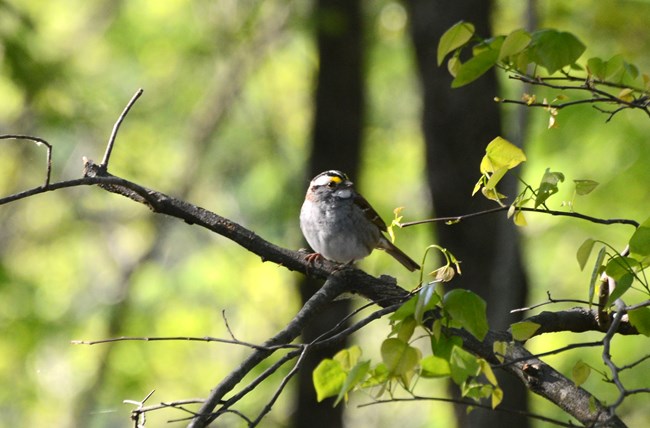
© Bill Telfair White-throated Sparrow (Zonotrichia albicollis)• Though they look nothing alike and aren’t closely related, sometimes White-throated Sparrows and Dark-eyed Juncos mate and produce a hybrid of the two. The resulting young hybrid looks grayish and is dully marked with white outer tail feathers.• White-throated Sparrows tend to stay near the ground and like to scratch through the leaves and leaf litter in search of food. They use both feet at the same time to scratch at the leaves and pounce forwards if they find anything. They often do this in large groups. • Instead of walking White-throated Sparrows hop when they’re on the ground. • They like to build nests just above the ground under shrubs, grasses, ferns and sometimes they place their nests under dead vegetation. Identification Information• Size: Sparrow sized or smaller (Small)• Color: White-throated Sparrows are brown on their backs and feathers and gray on their bellies but they have a very distinctive patterning on their heads. They have a black and white striped head with a bright white throat and a yellow patch between their eyes and their beak. 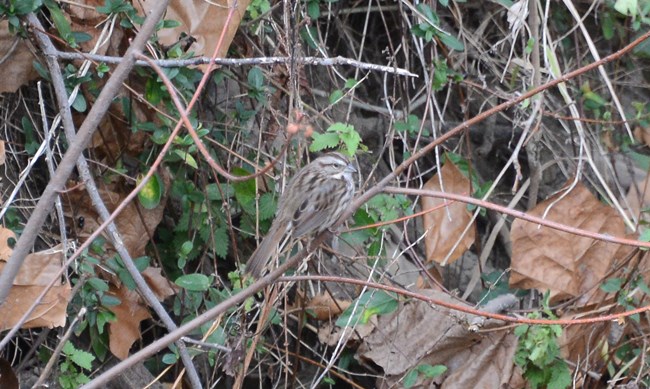
© Bill Telfair Song Sparrow (Melospiza melodia)• Song Sparrows are very particular about where they place their nests. Specific spots get used over and over again even when entirely new birds take over a territory.• Like other songbirds, male Song Sparrows use song to attract mates and to defend their territory. Studies have shown that females are not just attracted to the song they sing but how well the song reflects the ability of the male to learn new components. • Song Sparrows search for nest sites as a pair and these sites are usually hidden in grasses or weeds. Sometimes they are placed on the ground but sometimes they’re as high as 15 feet above the ground. • They love to eat insects and other invertebrates (no backbone) in the summer but they eat seeds and fruits all year round. Identification Information• Size: Sparrow sized or smaller (Small)• Color: Song Sparrows are streaked with brown and white. They have a white belly with thick brown streaks. Their head is a mixture of reddish/brown and slate gray. 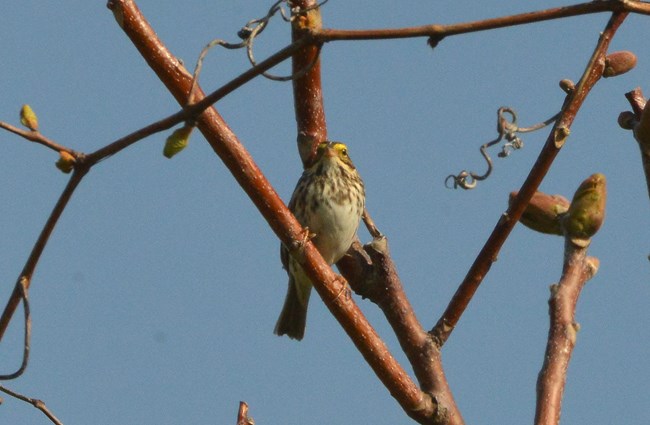
© Bill Telfair Savannah Sparrow (Passerculus sandwichensis)• Female Savannah Sparrows have to gather 10 times their weight in food to feed themselves and their young during the 8 days they’re in the nest.• Savannah Sparrows walk on the ground to look for bugs and they sometimes run or hop to seize their prey. • If another Savannah Sparrow enters a male’s territory they sometimes use what is called a “flutter flight” to scare them away. This “flutter flight” involves flying up with his tail up and legs dangling while he beats his wings slowly as he hovers in the air. • They love to eat insects and spiders full of nutrients and the look through grassy areas or beaches in search of this nutritious snacks. Identification Information• Size: About the size of a Song Sparrow (Extra Small/Small)• Color: Savannah Sparrows are brown on their backs and wings and white on their bellies but they have streaks of color on both. Their top half is brown with black streaks and their underparts are white with thin brown or black streaks. They also have a small yellow patch on their face in front of their eyes. 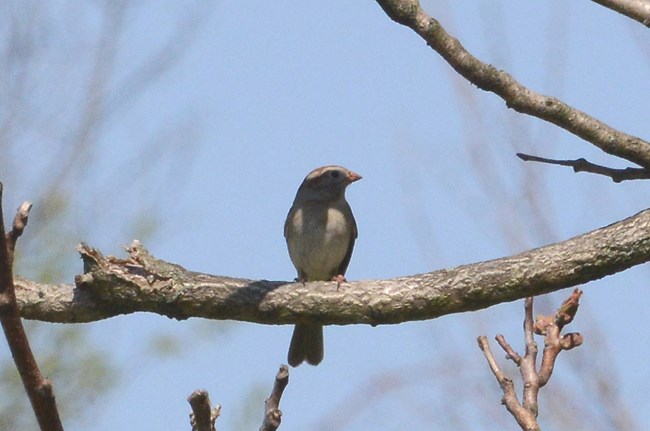
© Bill Telfair Field Sparrow (Spizella pusilla)• Male Field Sparrows like to return to breed in the same territory every year. Females are not very likely to return to the same territory and young sparrows very rarely return to the place they were born the next year.• Male Field Sparrows will start singing as soon as they get back to their territory in the spring. They will sing all the time until they find a mate and then they will only sing occasionally. • When female Field Sparrows first arrive on breeding grounds of a males territory they receive a rude welcome from the males. Unmated males will sometimes fly and strike at a female on his territory sometimes knocking her to the ground. This seems to appease him because he then follows his new mate around closely as she looks for a nest site. • Like other sparrows, Field Sparrows have a particular way of feed on grass seed heads. First they fly to the top of a tall grass stem, then they use their body weight to ride the stem to the ground where they then pin the seed head to the ground and pluck individual seeds. Identification Information• Size: Sparrow sized or smaller (Extra Small/Small)• Color: Field Sparrows are brown with black streaks with a distinct white eyering, a pink bill, and they have a gray belly with orange highlights. Their head is a light gray with a light brown coloring on the top of their head and a brown patch behind their eyes. 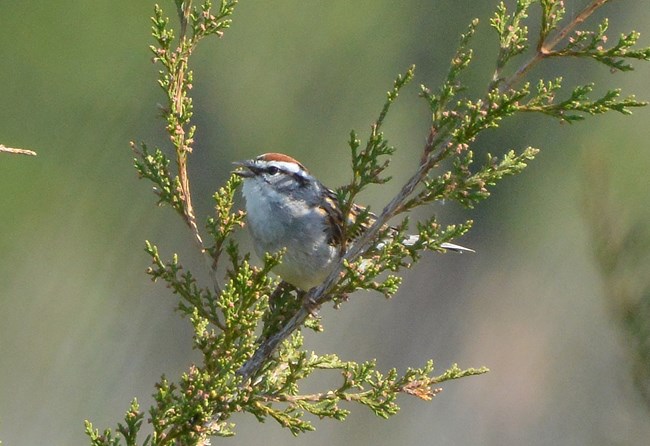
© Bill Telfair Chipping Sparrow (Spizella passerina)• When building a nest, Chipping Sparrows usually build them low in a shrub or tree but occasionally they will get a little more creative with their nest placement. Their nests have been found in places like hanging among strands of chili peppers, on an old fashioned mower, and on a hanging basket filled with moss.• Females can be very choosy about where they put a nest. They often start building a nest and then leave it to start building in a different spot. The males will guard the females while they are building but they don’t help her build the nest. • During the breeding season, males will defend their territories against other Chipping Sparrows but they will usually tolerate other species being in their territory as long as they don’t get too close to their nest. • Chipping Sparrows mainly eat seeds of many different grasses and herbs but during the breeding season they will also hunt for insects that are healthy and full of protein. Identification Information• Size: Sparrow sized or smaller (Extra Small/Small)• Color: In the summer, Chipping Sparrows have gray bellies with a pale gray face and a black line through their eyes, with an orangish/brown cap on their heads. In the winter, Chipping Sparrows coloring is not as prominent and they are a light brown with dark streaked bellies. They still have a black line through their eyes and a orangish/red cap but they are duller than in the summer.
All of the above information is an abbreviated version of information gathered from the Cornell Lab of Ornithology. Please visit their website for more in-depth bird information.
|
Last updated: September 16, 2019
